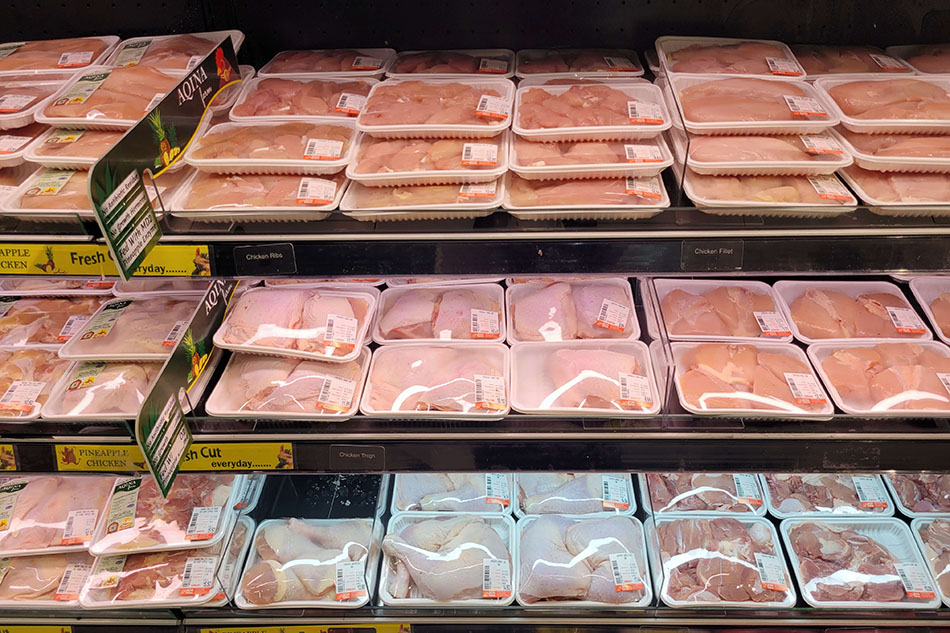From staff reports
At the Annual Meat Conference, held March 24-26 in Orlando, Florida, industry leaders convened to discuss the evolving landscape of the meat and poultry sectors.
For the 2025 Meat and Poultry Market Outlook presentation, key speakers included Brian Earnest, lead protein industry analyst at CoBank; Christine McCracken, executive director and protein analyst at Rabobank; Lee Schulz, chief economist, Ever.Ag; and Randy Blach, CEO, CattleFax.
Consumer behavior, demand dynamics

Brian Earnest highlighted the exceptional demand in the animal protein sector, attributing it to consumers’ COVID-19 pandemic-induced habits.
“Over the last couple years, we’ve seen this development of the consumer, that they’re more willing to cook foods at home, pulling those restaurant experiences back to their home,” he noted.
Quality remains a pivotal factor driving consumption.
Earnest also addressed the impact of inflation on consumer spending, pointing out that food products constitute a relatively small portion of overall expenditures.
He pointed out the demographic shift toward an aging population, with the median age approximately 10 years older than two decades ago, leading to smaller households and a preference for smaller portions.
“Convenience is still key. But also, I think the premiumization of it still plays in for this group as well,” Earnest added.
Wealth distribution, economic implications
Discussing economic factors, Earnest highlighted the significant growth in generational wealth – from $30 trillion in 1990 to $180 trillion currently. However, he noted that Millennials, holding about $24 trillion, face greater liabilities compared to previous generations, prompting a heightened focus on budgeting and financial scrutiny.
Earnest traced the evolution of the U.S. labor market, noting that agricultural employment has dwindled from 55 percent in 1850 to less than 2 percent today.
“Roughly 80 percent of Americans are employed in some sort of services role,” he said, underscoring the economy’s transition toward service-oriented employment.
Poultry consumption trends
Highlighting poultry’s prominence, Earnest observed, “We’ve seen phenomenal growth and consumption overall for the animal protein space. A large chunk of that has been taken up by chicken.”
Over the past decade, chicken consumption has increased by about 18 pounds per person annually. Factors such as low grain feed costs and consumer preferences for taste, freshness, price and nutrition continue to bolster this trend.
Technological integration in cooking
The rise of kitchen technologies like air fryers has influenced cooking habits.
“There are more air fryers in households today than there are coffee makers in the United States,” said Earnest, noting that two-thirds of U.S. homes now own the cookers, leading to packaging adaptations to include relevant cooking instructions.
Export markets, trade considerations
Earnest emphasized the importance of export markets for certain animal protein products. For instance, chicken paws [feet] can fetch about $3 per pound in China, while pork variety meats represent a $1.3 billion market internationally. These are items that don’t really have a market in the U.S., he noted.
Overall, animal protein and dairy exports present a $35 billion opportunity for U.S. producers.
Earnest also said it is important to think about the consumer.
“They’re thinking about your products in a whole new way. They’re bringing in that experience they had at the restaurant; they want to bring that into their home,” he said. “And overall, that global mindset continues to be a driver.”
[RELATED: Consumer Spending Shifts In Meat, Seafood, Poultry Amid Economic Uncertainty]
Poultry industry challenges

Christine McCracken addressed challenges facing the poultry industry, including disease threats such as avian influenza, trade disruptions and regulatory issues.
Despite favorable margins, growth remains constrained due to factors such as genetic adjustments aimed at improving meat quality and various viral diseases affecting bird health.
She said while bird flu has been an issue for the egg and turkey industries, “it hasn’t been a big issue for broilers.” She added that the spike in egg prices is not all supply related but has been exacerbated by strong demand.
“Egg supplies are stabilizing a bit as we work through some of these bird flu issues, but this is an endemic issue that will continue to challenge the industry.”
McCracken also noted that demand for poultry has been “super good, not just in the U.S. but in export markets because chicken is universally now the protein of choice.”
Feed costs, production outlook
McCracken noted that declining feed costs have supported increased bird weights, partially offsetting supply constraints. However, concerns about drought conditions affecting corn production pose potential risks to feed prices.
“Fifty-three percent of land where our primary corn [is] grown is in the middle of a drought,” she said. “The odds of drought in any year are high, but seed technology and our farmers’ ability to grow the crop have improved to a point that it takes some of that risk off.
“When we think about the global market and grain prices going forward, perhaps the bigger risks to feed costs have more to do with trade policy.”
Market dynamics, consumer preferences
The poultry market is experiencing shifts in product demand. Breast meat remains a growth driver, and there has been “a bit of a buildup in breast meat inventory,” McCracken said.
Wing prices have declined with the move to boneless wings, which occurred when traditional wings were in short supply last year. She also noted the growing domestic appetite for dark meat, traditionally exported, which has helped balance the market and reduce export reliance.
Turkey industry adjustments
The turkey sector faces challenges from avian influenza and shifting consumer preferences. However, McCracken commended the industry’s adaptability in adjusting production to restore market balance.
In summary, while the meat and poultry industries face multifaceted challenges, McCracken said the poultry industry is in “relatively good shape. There will be plenty of chicken, turkey and a few less eggs going into this year but some fairly good margins that should keep the industry encouraged to continue to produce. The demand picture couldn’t be better for poultry.”
Pork market: Stability amid shifting demand
Lee Schulz highlighted a mixed outlook for the pork industry, emphasizing that consumer willingness to pay impacts profitability.

“Every dollar that consumers are willing and able to pay for pork contributes to the profitability of the pork industry,” he stated.
While 2024 showed some positive trends in pork demand, overall demand declined by 1 percent compared to 2023.
“Consumers ate more pork; they actually paid higher nominal prices. But once we adjust for inflation, actual prices were lower compared to year over year in 2023,” Schulz explained.
He pointed to strong exports as a driver of demand but noted potential uncertainties for 2025. Mexico remained a bright spot, accounting for 34 percent of U.S. pork exports.
“Now, 2024 was a stellar year for pork exports,” he said. “Not only did our export customers eat more pork, to the tune of about 4.3 percent, but they paid higher prices for it.”
Wholesale pork demand remained robust, with pork cutout values showing strength, particularly in hams and bellies. However, ribs, picnics, butts and loins have seen some price softening. Schulz attributed the tight pork cold storage levels to increased costs.
“If I look at February 2017 compared to February 2025, we’ve seen about a 34 percent increase in that cost,” he said.
The industry also is grappling with sticky production costs. Schulz emphasized that inflationary pressures on corn, soybeans and distillers’ grains remain a challenge. “The difference today is everything else costs more. Those inflationary costs are here to stay.”
USDA forecasts pork production to rise 2.3 percent in 2025, with improved productivity driving record output. “We’re rivaling producing over 5,000 pounds per breeding animal annually,” Schulz remarked.
Despite recovering profitability, cumulative industry losses since 2020 remain significant.
Schulz noted that exports are expected to continue to grow under baseline situations.
“I think the important thing to keep in mind about tariffs is it’s not a ban. Our products will still flow. We’ll have prices adjust to make those markets move.”
[RELATED: Mapping Out The Meat Consumer Journey]
Beef market: Navigating tight supply, demand shifts
Randy Blach painted a picture of a beef industry constrained by supply-side challenges.

“For those of you that don’t have a real robust background in cattle production, it all starts with green grass, feed and water,” he said, pointing to ongoing drought conditions that have limited herd expansion.
“The beef cow herd is at the bottom,” said Blach, adding that recovery will be gradual through 2030-31 due to minimal heifer retention. Interest rates, now at 8-10 percent, also have weighed on expansion decisions.
Supply limitations are particularly evident in the ground beef market.
“Last year’s cow slaughter was down a million head. Think about what that does to the supply of lean beef,” he said. “We’re going to see further declines as we start to hold a few more cows back.”
This dynamic has driven record-high prices for 90 percent lean beef, currently at $3.70-$3.80 per pound.
In response, the U.S. has increased imports of lean beef from Australia, New Zealand, Brazil, Canada and Mexico. “Over 50 percent of the beef consumption in the United States is in the form of ground beef. So you can see how we’re fixing that void,” Blach said.
Despite a 45-million-head drop in total cattle inventory since 1975, the industry has achieved record beef production, thanks to heavier carcass weights.
“Last year, carcass weights were up 26 pounds – that was the equivalent of harvesting another million head,” he noted.
Looking ahead, Blach anticipates continued tight cattle supplies for another two years, driving higher prices.
“The bulk of the price increase in this cycle will take place in 2025 or early 2026,” he predicted.
Consumer trends: Shift in protein preferences
Blach underscored how consumer preferences have reshaped the industry. Beef consumption has declined from 80 pounds per capita in the 1980s to 58-59 pounds today, while poultry consumption has doubled to over 100 pounds per capita.
“Tough for the beef industry to compete from a cost standpoint of poultry,” he said.
However, the focus on quality has bolstered beef demand. “Retail beef prices have gone up 4.5 percent. That’s real demand growth,” Blach noted.
Choice and Prime grades now make up 85 percent of beef production, compared to 50 percent in 1980.
Blach also highlighted the importance of exports, as the U.S. ships 17 billion pounds of protein annually. “The export markets are critical for us,” he said.
As markets continue to evolve, all four experts stressed the importance of monitoring macroeconomic factors, consumer preferences and global trade policies. With continued volatility in the protein markets, adaptability will be key for producers and retailers alike.

